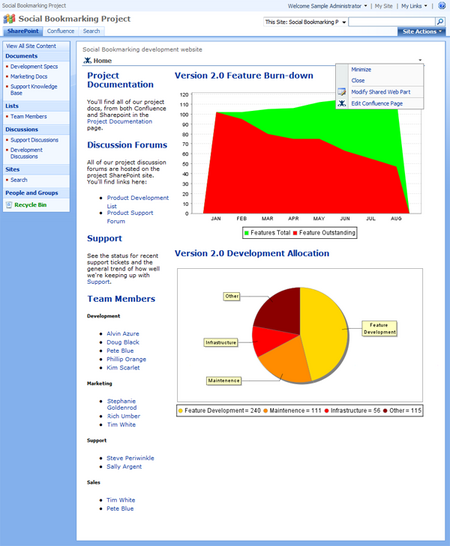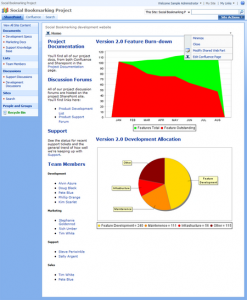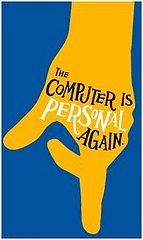confluence
1: a coming or flowing together, meeting, or gathering at one point <a happy confluence of weather and scenery>
2 a: the flowing together of two or more streams
b: the place of meeting of two streams
c: the combined stream formed by conjunction
Today we’re seeing the confluence of two worlds: the flow-oriented thinking and collaboration, represented by Confluence, the market-leading enterprise wiki, and the more traditional approach of documents, lists, folders, represented by Microsoft SharePoint. Or perhaps it’s a right-brain / left-brain thing. I’ve talked about it at length, and since Jeremiah, Web Prophet says backlinking is OK, I’ll just do that, instead of repeating myself: Flow vs. Structure: Escaping From the Document & Directory Jungle.
Now, as important forward-looking visioning is, successful business leaders recognize what the market wants today, not where they’d like to lead them tomorrow. Recognizing that Microsoft Office is deeply entrenched in the corporate workplace, Atlassian first added Webdav capabilities to Confluence (drag-and-drop files into the wiki, single click on attachment to edit them in the original MS Office format and save back to the wiki). But customers wanted more, according to Jeffrey Walker, President:
..meeting with customers and analysts, SharePoint came up in every meeting. “We have growing groups who love the wiki, and long standing users of Microsoft and now SharePoint. Help!”, customers asked..
The result of today’s joint Microsoft and Atlassian announcement of the SharePoint Connector for Confluence. The initial features include:
- Search: Users can search SharePoint and Confluence content together from one place.
- Content sharing: From within SharePoint, users can embed Confluence page contents allowing users to blend content. This also includes Confluences numerous plugins.
- Linking: Within Confluence, users can access SharePoint document facilities. By including SharePoint lists and content within Confluence, users, in a single click, can edit Microsoft Office documents.
- Single Sign-On and Security: With one login, users can access both systems while seeing only what they have permission to view.
In short, access your information, whether you’re the wiki-flow type or the create-save-hide-in-folders type 

The screenprint above shows a Confluence page (with the charting plugin) embedded within, and editable directly from SharePoint. For more, check out the feature tour.
Jevon MacDonald is pondering about the business realities behind this deal:
The question that weighs most heavily is: is there enough incentive for Microsoft to participate in this partnership in any significant way? The immediate economics aren’t obvious for Microsoft, which leaves us with two options:
– but I’m not giving those options away, you’ll have to read his post. (as an aside, he is the only one examining the business side, but his post is not on TechMeme – let’s see if we can push it there )
)
Speculation aside, some numbers: SharePoint has 80 million users while Atlassian Confluence has 4,100 customers – I don’t know how many users that translates to, but I’ve just written about SAP’s SDN/BPX communities which has about a million (!) users, and Confluence is a significant part of it. That said, Jeffrey said it right, David kisses Goliath in this deal.
There is no marketing agreement behind it, but I wouldn’t be surprised to see Microsoft’s huge reseller channel show interest in Confluence. And frankly, just removing the “we’re a SharePoint-shop” political obstacle in some major enterprise client is worth it alone.
Sour grapes? Competitor Socialtext announced their SharePoint integration a year ago, and CEO Ross Mayfield says SharePoint wiki was last year’s news. Well, I think Socialpoint, the Socialtext/SharePoint integration was last year’s news, this year’s news is Confluence.
Perhaps next year’s news will be which enterprise wiki vendor could translate their deals into real market gains. 
Update: here’s a video interview with CEO Mike Cannon-Brookes and President Jeffrey Walker on ScobleShow.
HOT! EXCLUSIVE! Here’s the real price Mike had to pay for this deal… just compare his looks above with this video. What’s next? A suit and tie? 
Related posts: Read/WriteWeb, Computerworld, Don Dodge, Atlassian News, WebProNews, Between the Lines, Ross Mayfield’s Weblog, Irregular Enterprise, Radiowalker, elliptical , eWEEK.com, Socialwrite, Trends in the Living Networks, Rebelutionary.
Update (10/19): Intriguing thoughts on wiki plug-ins, KM Web-services and Enterprise SOA on – surprise, suprise! – the SAP Community Network



 Considering how many things
Considering how many things 
 Since I’ve just advocated
Since I’ve just advocated 
 Digg competitor Reddit has been unhealthy lately. Yesterday it spent all day in read-only mode citing a database update which would be completed in a a few hours. Today it appears to be back, but it does not accept my login credentials. No worries, that’s what password recovery is for – except on Reddit, where it returns a
Digg competitor Reddit has been unhealthy lately. Yesterday it spent all day in read-only mode citing a database update which would be completed in a a few hours. Today it appears to be back, but it does not accept my login credentials. No worries, that’s what password recovery is for – except on Reddit, where it returns a 





Recent Comments